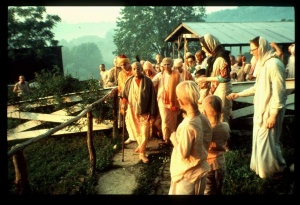CC Madhya 8.61 (1975): Difference between revisions
(Vanibot #0027: CCMirror - Mirror CC's 1996 edition to form a basis for 1975) |
(Vanibot #0019: LinkReviser - Revise links, localize and redirect them to the de facto address) |
||
| Line 2: | Line 2: | ||
<div style="float:left">'''[[Sri Caitanya-caritamrta (1975)|Śrī Caitanya-caritāmṛta (1975)]] - [[CC Madhya (1975)|Madhya-līlā]] - [[CC Madhya 8 (1975)|Chapter 8: Talks Between Śrī Caitanya Mahāprabhu and Rāmānanda Rāya]]'''</div> | <div style="float:left">'''[[Sri Caitanya-caritamrta (1975)|Śrī Caitanya-caritāmṛta (1975)]] - [[CC Madhya (1975)|Madhya-līlā]] - [[CC Madhya 8 (1975)|Chapter 8: Talks Between Śrī Caitanya Mahāprabhu and Rāmānanda Rāya]]'''</div> | ||
<div style="float:right">[[File:Go-previous.png|link=CC Madhya 8.60 (1975)|Madhya-līlā 8.60]] '''[[CC Madhya 8.60 (1975)|Madhya-līlā 8.60]] - [[CC Madhya 8.62 (1975)|Madhya-līlā 8.62]]''' [[File:Go-next.png|link=CC Madhya 8.62 (1975)|Madhya-līlā 8.62]]</div> | <div style="float:right">[[File:Go-previous.png|link=CC Madhya 8.60 (1975)|Madhya-līlā 8.60]] '''[[CC Madhya 8.60 (1975)|Madhya-līlā 8.60]] - [[CC Madhya 8.62 (1975)|Madhya-līlā 8.62]]''' [[File:Go-next.png|link=CC Madhya 8.62 (1975)|Madhya-līlā 8.62]]</div> | ||
{{CompareVersions|CC|Madhya 8.61|CC 1975|CC 1996}} | |||
{{RandomImage}} | {{RandomImage}} | ||
==== TEXT 61 ==== | ==== TEXT 61 ==== | ||
<div class="verse"> | <div class="verse"> | ||
:prabhu kahe, | :prabhu kahe,--"eho bāhya, āge kaha āra" | ||
:rāya kahe, | :rāya kahe,--"svadharma-tyāga, ei sādhya-sāra" | ||
</div> | </div> | ||
| Line 18: | Line 17: | ||
<div class="synonyms"> | <div class="synonyms"> | ||
prabhu kahe—the Lord replied; eho—this; bāhya—external; āge—ahead; kaha—speak; āra—more; rāya kahe—Rāmānanda Rāya replied; sva-dharma-tyāga—relinquishing | prabhu kahe—the Lord replied; eho—this; bāhya—external; āge—ahead; kaha—speak; āra—more; rāya kahe—Rāmānanda Rāya replied; sva-dharma-tyāga—relinquishing one's occupational duties; ei—this; sādhya-sāra—the essence of all perfection. | ||
</div> | </div> | ||
| Line 25: | Line 24: | ||
<div class="translation"> | <div class="translation"> | ||
"This is also external," Śrī Caitanya Mahāprabhu said. "Please proceed and speak further on this matter." Rāmānanda Rāya replied, "To give up one's occupational duties in the varṇāśrama is the essence of perfection." | |||
Rāmānanda Rāya replied, | |||
</div> | </div> | ||
| Line 33: | Line 31: | ||
<div class="purport"> | <div class="purport"> | ||
A brāhmaṇa may renounce his family and accept sannyāsa. | A brāhmaṇa may renounce his family and accept sannyāsa. Others also-kṣatriyas and vaiśyas-may also give up their families and take to Kṛṣṇa consciousness. Such renunciation is called karma-tyāga. By such renunciation, the Supreme Personality of Godhead is satisfied. But this renouncing of one's activities to Kṛṣṇa is not uncontaminated and is therefore on the material platform. Such activities are considered within the material universe because, according to Śrī Caitanya Mahāprabhu, they refer to the material universe and are therefore external. To correct this, Rāmānanda Rāya recommended that one take to the renounced order of life in order to transcend material activities. This is supported by the following verse from Śrīmad-Bhāgavatam ([[SB 11.11.29-32|11.11.32]]). | ||
</div> | </div> | ||
Latest revision as of 16:32, 18 September 2020

A.C. Bhaktivedanta Swami Prabhupada
TEXT 61
- prabhu kahe,--"eho bāhya, āge kaha āra"
- rāya kahe,--"svadharma-tyāga, ei sādhya-sāra"
SYNONYMS
prabhu kahe—the Lord replied; eho—this; bāhya—external; āge—ahead; kaha—speak; āra—more; rāya kahe—Rāmānanda Rāya replied; sva-dharma-tyāga—relinquishing one's occupational duties; ei—this; sādhya-sāra—the essence of all perfection.
TRANSLATION
"This is also external," Śrī Caitanya Mahāprabhu said. "Please proceed and speak further on this matter." Rāmānanda Rāya replied, "To give up one's occupational duties in the varṇāśrama is the essence of perfection."
PURPORT
A brāhmaṇa may renounce his family and accept sannyāsa. Others also-kṣatriyas and vaiśyas-may also give up their families and take to Kṛṣṇa consciousness. Such renunciation is called karma-tyāga. By such renunciation, the Supreme Personality of Godhead is satisfied. But this renouncing of one's activities to Kṛṣṇa is not uncontaminated and is therefore on the material platform. Such activities are considered within the material universe because, according to Śrī Caitanya Mahāprabhu, they refer to the material universe and are therefore external. To correct this, Rāmānanda Rāya recommended that one take to the renounced order of life in order to transcend material activities. This is supported by the following verse from Śrīmad-Bhāgavatam (11.11.32).